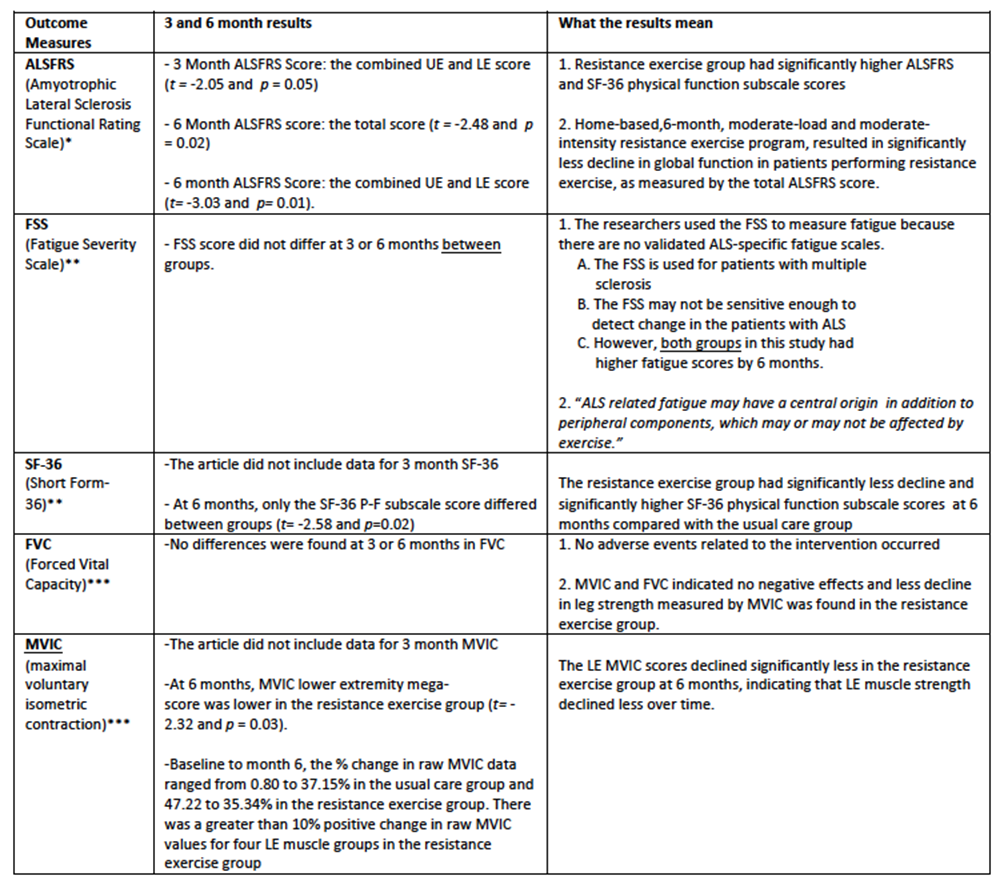Can you name the most fatal and common adult motor neuron disease?
Posted on 21st January 2014 by Renee DeVos Riggs

Can you name the most fatal and common adult motor neuron disease? At one point in time, I could not tell you what the most fatal and common adult motor neuron disease is. That is because I knew nothing about Amyotrophic Lateral Sclerosis or ALS until just a few years ago. I first learned of this disease during my first career as a school teacher, when my co-workers husband lost his battle to ALS. Then, prior to getting accepted into physical therapy (PT) school, my grandfather-in-law was diagnosed with ALS, which took his life during my first year as a PT student. In the past twelve months, I have learned of two more individuals receiving a diagnosis of ALS: my husband’s cousin and a friend from his hometown. Needless to say, I have become far better acquainted with this disease of unknown etiology, which currently affects 2 in 100,000 people.
As a future physical therapist, my greatest interest lies in researching what I can do to help individuals with ALS live the best life possible, given their condition. This disease is degenerative in nature and is fatal, so my expectation is not to improve their condition, but to slow the disease process and increase the quality of these patient’s lives. With those goals in mind, I set out to find information on the best therapeutic exercise for patients with ALS. The research was very limited, but in my search, I came across the article, A randomized controlled trial of resistance exercise in individuals with ALS, 1 by V. Dal Bello-Haas, et al. This group of researchers was also seeking the best treatment for patients with ALS.
Can physical therapy help?
Whether or not to implement an exercise regimen with people who have ALS has been long debated; this may be due to the possibility of damage, thought to be caused by excessive exercise. The objective of this study by Bello-Haas, et al. was to determine the effects of resistance exercise on function, fatigue, and quality of life in individuals with ALS. These researchers spent roughly 5 years and 8 months to recruit subjects with ALS (with a diagnosis of clinically definite, probable, or laboratory-supported ALS) for their study. The difficulty in recruiting subjects for the study was due, in part, to the fact that the availability of pharmaceutical trials for patients with ALS has been increasing.
One randomized controlled trial (RCT), of resistance exercise in patients with ALS, shows promising results.
Despite the difficulty and time required to recruit subjects for this trial, 18 subjects, randomly assigned to one of two groups completed this 6 month study. 10 participants completed the trial in the usual care group, which served as the control, and 8 of the participants completed the trial in the resistance exercise group. Subjects placed in the usual care group completed once-daily upper extremity (UE) and lower extremity (LE) stretching exercises only. Individuals placed in the resistance exercise group participated in both a once daily stretching exercise program plus a, 3x/week, UE and LE resistance exercise program, that were individualized, performed in the comfort of the participants home, and of moderate load and moderate intensity.
How did they do it?
The chart below shows the outcome measures used in the study, that were completed by each participant at baseline, then baseline characteristics were analyzed using t test, X2, or Fisher exact test at 3 months and 6 months during the study (p<0.05 was considered to be significant for all test):

*=Primary outcome measures; **=Secondary outcome measures; ***=Outcome measures to monitor for signs of adverse effects of the prescribed exercise.
Descriptions and explanations of the outcome measures used
The Amyotrophic Lateral Sclerosis Functional Rating Scale (ALSFRS) is a questionnaire, assessing the functional status of patients with ALS. It is often used to monitor and record an individual’s change in functional abilities over time by measuring Measures: speech, salivation, swallowing, handwriting, cutting food and handling utensils (with or without gastrostomy), dressing and hygiene, turning in bed and adjusting bed clothes, walking, climbing stairs, breathing. When using the ALSFRS, the higher the score, the better the functional ability of the individual.2
Fatigue Severity Scale (FSS) is a questionnaire that measures the severity of fatigue and how much that fatigue affects an individual’s activities and lifestyle. When using the FSS, the higher the score, the greater the fatigue and the more it affects an individuals’ activities and lifestyle.3
The Short Form 36 (SF-36) is a questionnaire that is an easily administered quality-of-life measures. Quality-of-life measures do just that, they measure the quality that you perceive of your life, based on how you answer the questions. These questions are based on vitality, physical functioning, bodily pain, general health perceptions, physical role functioning, emotional role functioning, social role functioning, and mental health. When using the SF-36, the higher the score the less disability (i.e. a score of zero is equivalent to maximum disability and a score of 100 is equivalent to no disability).4
– An on-line version of the SF-36 is available at: http://www.sf-36.org/demos/SF-36.html and your score is instantly calculated at completion of the questionnaire. This website provides you with results that are immediately displayed, along with the norms for that test, as well as your total scores based on the questions related to the physical components and mental components of the test.5
Forced Vital Capacity (FVC) is a lung function test that measures the amount of air and the speed at which the air can be inhaled and exhaled. The results can then be compared to norms (that are based on age, gender, height, body size, and race) or compared with previous or future tests of the same individual. 6
Maximum Voluntary Isometric Contraction (MVIC) is a tool that measures muscle strength. This is performed in a variety of ways depending on the muscle being tested, but it all instances, the participant performs a static contraction (one in which there is no movement at the joint) at maximal intensity. The results can then be compared with previous or future tests of the same individual. 7
Conclusion
The results of this randomized controlled trial (RCT) shows favorable results from a moderate load and moderate intensity resistance exercise program for individuals with ALS and a resistance program may be an essential component of the overall care of patients with this disease. 1 Encouragement, to participate in an individualized resistance exercise regimen, should be provided to individuals with ALS. Programs should be designed so that the individual is not brought to fatigue, as this could cause adverse effects, but rather work at a moderate intensity to benefit in such a way as to avoid atrophy and other complications associated with disuse. Avoiding or even delaying such complications could maintain or minimize loss in the patient’s mobility and allow the patient to function for a longer period. This benefits not only the individual with ALS, but by staying mobile longer this decreases the patient’s need for assistance with ambulation, transfers, and activities of daily living (ADLs). Another benefit taken directly from the article states that:
Patients who participate in an exercise program may have a greater sense of control over what is happening to their bodies. These psychological benefits may enable patients to better maintain optimal functional independence and enhance their quality of life and well-being throughout all stages of the disease. 1
As a future clinician
As a future clinician in the field of physical therapy, unless contradictory research is released before I begin my career as a PT, I will incorporate daily stretching as well as moderate load and moderate intensity resistance exercises (3x/week) for my patients with ALS when appropriate. Implementing such a program will, of course, depend on the patient’s goals and desires, as well as any limitations that may keep a patient from participating in such a program. I will individualize such a program to meet the patient’s needs, the stage in the disease process the patient is in, and I will plan specific exercises according to research backed by evidence.
References
1. Bello-Haas D, Florence M, Kloos AD, Scheirbecker J, Lopate G, Hayes SM, Pioro, Mitsumoto H. A randomized controlled trial of resistance exercise in individuals with ALS. Neurology. 2007; 68(23):2003-7.
2. The ALS C.A.R.E. Program Website. Available at: http://www.outcomes-umassmed.org/als/sf12.aspx. Accessed January 20, 2014.
3. Rehabilitation Measures Database Website. Available at: http://www.rehabmeasures.org/rehabweb/allmeasures.aspx?PageView=Shared.Accessed January 20, 2014.
4. Rand Health Website. Available at: http://www.rand.org/health/surveys_tools/mos/mos_core_36item.html. Accessed January 20, 2014.
5. SF-36® Health Survey Scoring Demonstration Website. Available at: http://www.sf-36.org/demos/SF-36.html. Accessed January 20, 2014.
6. Northern Arizona University Website. Available at: http://jan.ucc.nau.edu/~daa/lecture/pft.htm. Accessed January 20, 2014.
7. Informa Healthcare Website. Available at: http://informahealthcare.com/doi/abs/10.1080/14660820310006715?journalCode=aml. Accessed January 20, 2014.




No Comments on Can you name the most fatal and common adult motor neuron disease?